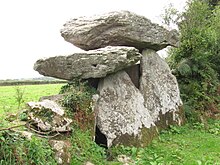 Knockeen Dolmen as seen from the front Knockeen Dolmen as seen from the front | |
 | |
| Region | Munster |
|---|---|
| Type | Portal tomb |
| History | |
| Builder | Unknown |
| Periods | Neolithic |
| Cultures | Celtic/Viking |
| Site notes | |
| Public access | Yes |
| National monument of Ireland | |
| Official name | Knockeen |
| Reference no. | 421 |
The Knockeen Portal Tomb is a megalith in Knockeen, County Waterford, Ireland. It is the largest dolmen (portal tomb) in County Waterford exhibiting a double capstone configuration, though it is not the tallest standing stone structure. It is one of the finest examples of a dolmen in Ireland.
Description


The Knockeen Portal Tomb has five large uprights and two capstones in total. There is a doorstone to the structure with straight faces that does not bear any of the overall weight. It is, however, similar in size to the other four standing stones. The monument measures 3.5 metres (11 ft) high and 2.1 metres (6 ft 11 in) wide. The orthostats (upright stones) measure up to 2.8 metres (9 ft 2 in) in height around a tightly closed interior chamber. The capstones lie at a nearly horizontal angle.
The interior chamber is accessed by a keyhole entrance at ground level, 0.8 metres (2 ft 7 in) in width, which may suggest spiritual offerings were placed inside the structure in ancient times. The front face and keyhole entrance face northwest under a porch-like structure formed by the lower capstone. An up-growth of vines and other plants rises over the base of the doorstone at the front, and encloses the rear of the structure.
Use

It is unclear exactly what the tomb was used for. It could have been the burial site of a Déisi chieftain from the nearby area, or it could have served a spiritual purpose. It has been noted that the entrance of the tomb aligns with the Sugarloaf hill to the northwest. This gives rise to the possibility of solar and lunar alignments during summer solstice and full moon cycles of the start and middle of the year. The site could also have been employed by local shamans or druids for various spiritual rituals.
Knockeen Portal Tomb is under state care as it is a listed national monument, number 421. The monument was once part of the cemetery of Kilbride Church, circa 18th century (now located in ruins in the northerly field), which has been reconstituted as pasture for cattle. As a result, electrical fencing runs less than a meter from the edge of the structure.
Knockeen Dolmen is part of "The Dolmen Drive" tourist trail and is accessed by climbing a gate, crossing a field, and navigating an electric fence.
See also
References
- "National Monuments in County Waterford" (PDF). National Monuments Service. Retrieved 9 June 2015.
- ^ "Knockeen Dolmen". Prehistoric Waterford. 2014. Archived from the original on 6 November 2012.
- ^ "Questioning Knockeen". The Silent Stones. 15 January 2014. Archived from the original on 4 September 2014.
- Crow, Philip Axtell (1990). The Intelligent Traveller's Guide to Historic Ireland. Contemporary Books. p. 21. ISBN 0809240629.
- Day, Catharina (2006). Ireland. New Holland Publishers. p. 221. ISBN 1860113273.
- "National Monuments in State Care: Ownership & Guardianship – Waterford" (PDF). archaeology.ie. 4 March 2009. Archived from the original (PDF) on 12 May 2014.
- "Knockeen Portal Tomb". Megalithic Ireland.
- "The Dolmen Drive" (PDF). Discover Tramore. Archived from the original (PDF) on 8 August 2013. Retrieved 23 September 2014.
External links
52°12′20″N 7°12′40″W / 52.2056°N 7.2112°W / 52.2056; -7.2112
Categories: